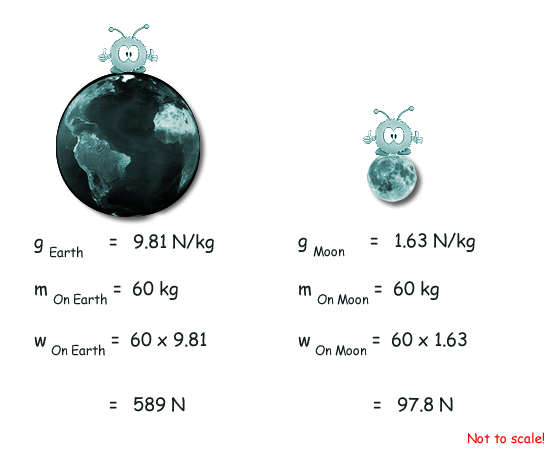Weight
The tug or hold of a gravitational field upon an object is a force - therefore weight is a force and is measured in newtons. The Earth pulls at each newton of mass in an object on its surface with a force of 10N.
We say that the gravitational field strength of Earth is 10N/kg - it pulls each kilogram of mass with a force of 10N.. Definition: weight is the force of gravity acting on a mass that is positioned in a gravitational field. There is an equation that links mass to weight in a gravitational field:
We incorrectly speak of our 'weight' being measured in kilograms - mass is measured in kilograms. Suppose my mass is 60 kg On Earth g = 10 N/kg (At GCSE - you 'round' 9.81 to 10 - to make the maths easier) Therefore my weight is 60 x 10 = 600 newtons. This is only true whilst I stay on Earth. On the moon, I would be very light and jumping would be very easy. This is because g (Moon) is only 1.63 N/kg. I would weigh roughly a sixth of what I did on Earth, but, sadly, it wouldn't mean I was any thinner..... I'd still have all those atoms and molecules that make up my mass - I would still need the same size of spacesuit - and my mass would still be 60 kg!
Click here to read Hannah's 'Mass and Weight Rap' - I taught Hannah a long time ago - she is a fully qualified medical doctor now - with a family of her own!
Weight always acts vertically downwards on the Earth's surface That is because Earth's gravity is pulling the mass towards its centre with the force of its weight
The weight of an object is distributed evenly around a point on the body called its 'centre of gravity'. The weight is said to 'act through the centre of gravity'. If you support it at this point it will balance. You can find this point on a flat shape by carrying out a simple experiment. The weight of a body can be represented by a force arrow that points vertically down from the centre of mass. The arrow shaft is the line of action of the force arrow. If the object is positioned on a sloping surface we have to resolve the weight vector to find the force pulling it down the slope and the reaction force with the ground. Measuring weight
|
Follow me...
|
|||||||||||





 See the
See the 


